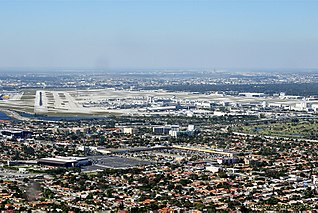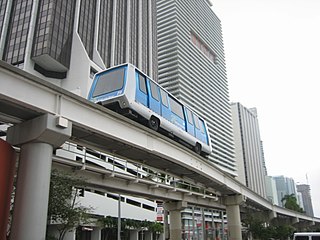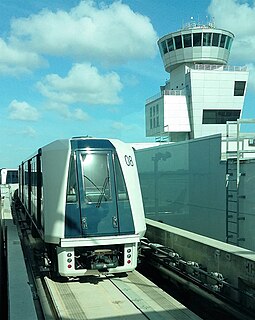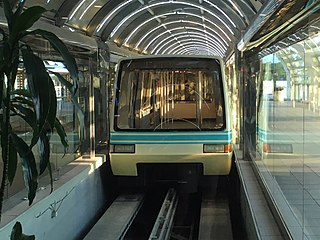
A people mover or automated people mover (APM) is a type of small scale automated guideway transit system. The term is generally used only to describe systems serving relatively small areas such as airports, downtown districts or theme parks.

Miami International Airport, also known as MIA and historically as Wilcox Field, is the primary airport serving the Miami area, Florida, United States, with over 1,000 daily flights to 167 domestic and international destinations, and one of three airports serving this area. The airport is in an unincorporated area in Miami-Dade County, 8 miles (13 km) northwest of Downtown Miami, in metropolitan Miami, adjacent to the cities of Miami and Miami Springs, and the village of Virginia Gardens. Nearby are the cities of Hialeah and Doral, and the Census-designated place of Fontainebleau.

Miami-Dade Transit (MDT) is the primary public transit authority of Miami, Florida, United States and the greater Miami-Dade County area. It is the largest transit system in Florida and the 15th-largest transit system in the United States. Ridership dropped 27% from 2010 to 2018. From 2014 to 2018, each year there fewer riders than the prior year.

Metromover is a free mass transit automated people mover train system operated by Miami-Dade Transit in Miami, Florida, United States. Metromover serves the Downtown Miami, Brickell, Park West and Arts & Entertainment District neighborhoods. Metromover connects directly with Metrorail at Government Center and Brickell stations. It also connects to Metrobus with dedicated bus loops at Government Center and Adrienne Arsht Center station. It originally began service to the Downtown/Inner Loop on April 17, 1986, and was later expanded with the Omni and Brickell Loop extensions on May 26, 1994.

Government Center station is an intermodal transit hub in the Government Center district of Downtown Miami, Florida. It is operated by Miami-Dade Transit and serves as a transfer station for the Metrorail and Metromover rapid transit systems and as a bus station for Metrobus, Paratransit, and Broward County Transit buses. The station is located near the intersection of Northwest First Street and First Avenue, a part of the Stephen P. Clark Government Center Building. It opened to service May 20, 1984, next to the site of a former FEC railway station which is now MiamiCentral.

Miami station is a train station in Miami-Dade County, Florida, on the border of Miami and Hialeah. It is the southern terminus for Amtrak's Silver Meteor and Silver Star trains. The station opened in 1978 to replace a 48-year-old Seaboard Air Line Railroad station. It is several blocks away from the Tri-Rail and Metrorail Transfer Station, but there is no direct connection between the two. The station was scheduled to be replaced by Miami Intermodal Center in 2016, but this was later postponed indefinitely.

An elevated railway or elevated train is a rapid transit railway with the tracks above street level on a viaduct or other elevated structure. The railway may be broad-gauge, standard-gauge or narrow-gauge railway, light rail, monorail, or a suspension railway. Elevated railways are normally found in urban areas where there would otherwise be multiple level crossings. Usually, the tracks of elevated railways that run on steel viaducts can be seen from street level.

Miami Intermodal Center (MIC) is an intermodal rapid transit, commuter rail, intercity rail, local bus, and intercity bus transportation hub in Miami-Dade County, Florida, just outside the Miami city limits near the Grapeland Heights neighborhood. The facility was constructed by the Florida Department of Transportation and is owned by the Miami-Dade Expressway Authority.

Metrorail is the heavy rail rapid transit system of Miami and Miami-Dade County in the U.S. state of Florida. Metrorail is operated by Miami-Dade Transit (MDT), a departmental agency of Miami-Dade County. Opened in 1984, it is Florida's only rapid transit metro system, and is currently composed of two lines of 23 stations on 24.4 miles (39.3 km) of standard gauge track. Metrorail serves the urban core of Miami, connecting the urban centers of Miami International Airport, the Civic Center, Downtown Miami, and Brickell with the northern developed neighborhoods of Hialeah and Medley to the northwest, and to suburban The Roads, Coconut Grove, Coral Gables, and South Miami, ending at urban Dadeland in Kendall. Metrorail connects to the Metromover in Downtown, which provides metro service to the entirety of Downtown and Brickell. Additionally, it connects to South Florida's commuter rail system at Tri-Rail station, as well as Metrobus routes at all stations. Together with Metromover, the system saw steady ridership growth per annum, with an average of 105,500 daily passengers in 2013.

The McCarran International Airport People Movers are three separate automatic people mover systems operating at McCarran International Airport near Las Vegas, Nevada. The people mover system consists of three separate lines: the Green Line connecting the Main Terminal to the C Gate Concourse, the Blue Line connecting the Main Terminal to the D Gate Concourse, and the Red Line connecting the D Gates Concourse to Terminal 3.

The C-100 is an automated people mover rolling stock first developed by Westinghouse Transportation Systems, which later became AEG-Westinghouse, AEG Transportation, and eventually Adtranz. A pioneer in the development of automated guideway transit, it was succeeded by Bombardier Transportation's CX-100, which is found at many airports today. The newer CX-100 is capable of using most of the existing infrastructure of the C-100, making it easy to upgrade to the newer vehicles. Because of this, production of the C-100 ceased upon Bombardier's acquisition of Adtranz in 2000.

The Jacksonville transportation network includes ground, air, and sea options for passenger and freight transit. The Jacksonville Port Authority (Jaxport) operates the Port of Jacksonville, which includes container shipping facilities at Blount Island Marine Terminal, the Talleyrand Marine Terminal and the Dames Point Marine Terminal. Jacksonville Aviation Authority managers Jacksonville International Airport in Northside, as well as several smaller airports. The Jacksonville Transportation Authority (JTA) operates bus, people mover, and park-n-ride services throughout the city and region. A major bus terminal at the intermodal Rosa Parks Transit Station serves as JTA's main transit hub. Various intercity bus companies terminate near Central Station. Amtrak operates passenger rail service to and from major cities throughout North America. The city is bisected by major highways, I-95 and I-10, I-295 creates a full beltway around the city.

The Skytrain is an airside automated people mover system operating at Miami International Airport. It operates within the airport's Concourse D, which is a major international hub for American Airlines. The system, which opened in 2010 as part of an expansion of Concourse D, can transport passengers from end to end of the mile long concourse in five minutes. The Skytrain is one of three separate automated people movers operating at the airport. The others are the MIA Mover, which connects to the Miami Intermodal Center, and the MIA e Train people mover connecting Concourse E's satellite building.

The Greater Miami area, composed of the three counties of Miami-Dade, Broward, and Palm Beach, also known collectively as South Florida, is home to a wide variety of public and private transportation systems. These include heavy rail mass transit (Metrorail), commuter rail (Tri-Rail), automated guideway transit (Metromover), highways, two major airports and seaports, as well as three county-wide bus networks, which cover the entire urbanized area of South Florida. Census and ridership data show that Miami has the highest public transportation usage of any city in Florida, as about 17% of Miamians use public transportation on a regular basis, compared to about 4% of commuters in the South Florida metropolitan area. The majority of public transportation in Miami is operated by Miami-Dade Transit (MDT), which is currently the largest transit system in Florida and was the 14th largest transit system in the United States in 2011.

The Orlando International Airport Intermodal Terminal or South Airport Intermodal Terminal is an intermodal transit complex under construction at the Orlando International Airport in Orlando, Florida. The new station, which is partially being funded by the Florida Department of Transportation, will serve as the Orlando station for the Brightline inter-city rail service, which will connect Orlando International Airport to downtown Miami via the Florida East Coast Railway. The terminal building and the adjacent parking garage opened on November 17, 2017, while work on the train terminal continues. The facility is connected to the main airport terminal roughly a mile to the north via an automated people mover (APM) system.

The Orlando International Airport People Movers are a set of automated guideway transit (AGT) people mover systems operating within Orlando International Airport. The four original people mover systems connect the airport's main terminal to four satellite airside concourses. A fifth AGT people mover system was installed in 2017 to connect the main terminal with the airport's new Intermodal Terminal.

The Tampa International Airport People Movers are a set of automated people mover systems operating within Tampa International Airport. The primary set of people movers are automated guideway transit (AGT) systems that connect the airport's main terminal to four satellite airside concourses. Opened in 1971, it is the first automated people mover system in the world built within an airport. A monorail connected the main terminal and the long-term parking garage from 1991 until its closure in 2020. A fifth AGT line known as SkyConnect began operating in 2018, and connects the main terminal with the airport's economy parking garage and rental car center.
The MIA e Train is one of three automated people mover systems operating at Miami International Airport. The MIA e Train connects the satellite building of Concourse E with the rest of Concourse E which is connected to the main terminal. The system opened in 2016 replacing an earlier system and was built at a cost of $87 million.
The LAX Automated People Mover is an automated people mover (APM) system currently under construction for Los Angeles International Airport. To be operated by Los Angeles World Airports, the LAX APM will be 2.25 miles (3.62 km) long and will have six stations that connect the Los Angeles Metro Rail, a consolidated car rental facility, and two intermodal transportation facilities with the airport terminals.



















